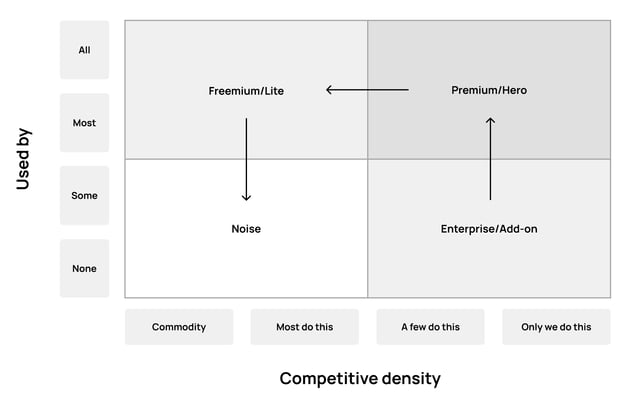To support your pricing, packaging, and promotion optimization, consider updating your competitive research. Ideally, you collect enough information to be able to position your products and services in a way that gives you an edge with your ideal customer profile. If possible, get enough data to create a feature matrix like you just did for the pricing strategy - this time for each of your competitors.

To find a list of your competitors the best place to start is to ask the sales team. You can also type your company name into Google and see who else is showing up (like this “my company vs. X”). If you are in an established category, chances are that companies like Capterra, G2 and Software Advice (part of Gartner), Forrester, and IDC can provide lists of your main competition as well.
My guide for managing your team's B2B SaaS sales, marketing, churn, and growth metrics to get your go-to-market on track.
READ ARTICLE
Start with collecting the following basic info about your competitors
- What is the #1 product they sell? Provide a short description, and what the benefits are. Do the same for their #2 and #3 product/service (if applicable).
- How do they describe their company and the solution? What’s it for?
- What is the “headline” in the browser title or when you find them on Google?
- What is the description on the homepage?
- How do they describe their audience? Who’s it for?
- What is their estimated revenue? And the growth rate the past few years?
- How many employees do they have?
- How many customers?
- How many business partners?
- Does the company boast any specific alliance, endorsement, or certification?
- Have they won any (product) awards?
- How many locations do they have?
Consider mystery shopping for each competitor. Research the pricing for their products and services. Try to buy the products/services of each competitor. Get detailed information that goes beyond what is published on the website. Use email and online chat (or call them) to get the scoop.
To allow an apples-to-apples comparison of the various players, create a typical customer profile that you use to get pricing information. For example:
- A midsize software company with 150 employees, and 10 potential users of the solution.
- 3 locations in the U.S., and about 5 years old.
- $18M+ in annual revenue. Fast-growing, about 25 percent YOY (so the vendor sees the potential to sell you more in the future).
- You prefer to pay-as-you-go and are okay paying for a year in advance.
Test their reachability through chat, phone, and email. Send them a note and record how long it takes them to get back to you. It is also interesting to capture the actual text of the response when they follow up. Does it feel automated? Do you see any best practices? Rate the customer experience from 1–10, 10 being the best.
Important: In each conversation, ask what the salesperson thinks of the competition (ideally of the company you work for, and a few others). This is key in uncovering important challenges that your prospects can bring up that you need to be prepared for.
More things to include in your competitive research
- How do you rate their online presence? The customer experience of the website? Is it easy to find and buy what you need? Try to rank all the companies you research based on your opinion.
- How many customer testimonials are listed on the website?
- What are the top 5 features presented on the website? Which are they giving the most attention?
- Consider running a semrush.com report for the company to evaluate the technical SEO quality of your competitors’ websites.
- Record things like the organic traffic they get vs. paid traffic, and what the top 5 keyword combinations are that drive their organic traffic. What keywords are they bidding on with their paid search efforts?
- Go to “domain analytics/overview” and run the domain overview report.
- Consider capturing the following data points in your spreadsheet: organic search, paid search, backlinks, display advertising, number of top organic keywords and the top 5 organic competitors.
- What does each competitor claim as their unique differentiation? Is there any mention of something they are “best” at, or that “only” they can do?
- Collect the features for the products and services that your competitor offers. You can put them in a simple sheet like this, and potentially even do this advanced product planning exercise.